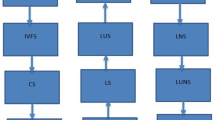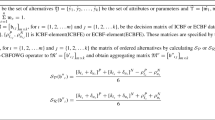Abstract
Most of the real-world decision making problems are based on the bipolar behavior of information evaluations. Bipolar fuzzy numbers as a generalization of fuzzy numbers are an efficient mathematical tool to cope with bipolar vagueness and uncertainty in data that frequently arise in human decision making problems. This research study focuses on the novel decision making techniqye by integrating the notion of trapezoidal bipolar fuzzy numbers with digraph and matrix approach. Firstly, the initial data in converted into trapezoidal bipolar fuzzy numbers to construct the interralation criteria matrices. Secondly, the bipolar fuzzy criterion matrix for each alternative is formed by interchanging the main diagonal entries of the interrelation matrix by the aggregated bipolar fuzzy numbers. Thirdly, the criterion priority index is obtained by defuzzifying the bipolar fuzzy criterion matrix using a score function for the assessment of the ordering of alternatives. The significance of the proposed approach is illustrated by an application example of agricultural farming for the assessment of greenhouse organic and inorganic farming systems. The effectiveness of the obtained results for the given decision-making problem is analyzed by providing a comparative study with the existing techniques.











Similar content being viewed by others
Data availability
No data were used to support this study.
References
Agrawal, S., Singh, R.K., Murtaza, Q.: Disposition decisions in reverse logistics: Graph theory and matrix approach. J. Clean. Prod. 137, 93–104 (2016)
Akram, M., Amjad, U., Davvaz, B.: Decision-making analysis based on bipolar fuzzy N-soft information. Comput. Appl. Math. 40(6), 182 (2021)
Akram, M., Arshad, M.: A novel trapezoidal bipolar fuzzy TOPSIS method for group decision-making. Group Decis. Negot. 28(3), 565–584 (2019)
Akram, M., Dar, J.M., Naz, S.: Certain graphs under Pythagorean fuzzy environment. Compl. Intell. Syst. 5(2), 127–144 (2019)
Akram, M., Dudek, W.A., Ilyas, F.: Group decision-making based on Pythagorean fuzzy TOPSIS method. Int. J. Intell. Syst. 34(7), 1455–1475 (2019)
Akram, M., Habib, A., Alcantud, J.C.R.: An optimization study based on Dijkstra algorithm for a network with trapezoidal picture fuzzy numbers. Neural Comput. Appl. 33(4), 1329–1342 (2021)
Akram, M., Habib, A., Ilyas, F., Dar, J.: Specific types of Pythagorean fuzzy graphs and application to decision-making. Mathematical and Computational Applications 23(3), 42 (2018)
Akram, M., Luqman, A.: Granulation of ecological networks under fuzzy soft environment. Soft. Comput. 24(16), 11867–11892 (2020)
Akram, M., Sarwar, M., Dudek, W.A.: Graphs for the analysis of bipolar fuzzy information, p. 452. Springer, Berlin (2021)
Akram, M., Shahzadi, S., Rasool, A., Sarwar, M.: Decision-making methods based on fuzzy soft competition hypergraphs. Compl. Intell. Syst. 8(3), 2325–2348 (2022)
Akram, M., Shumaiza Ahmad, N.A.: MCDM for selection of green suppliers under bipolar fuzzy PROMETHEE process. Symmetry 12(1), 77 (2020). https://doi.org/10.3390/sym12010077
Akram, M., Shumaiza, Arshad, M.: Bipolar fuzzy TOPSIS and bipolar fuzzy ELECTRE-I methods to diagnosis. J. Comput. Appl. Math.39, Article No. 7 (2019c)
Akram, M., Bibi, R.: Multi-criteria group decision-making based on an integrated PROMETHEE approach with 2-tuple linguistic Fermatean fuzzy sets. Granular Comput. 8(5), 917–941 (2023)
Alghamdi, M.A., Alshehri, N.O., Akram, M.: Multi-criteria decision-making methods in bipolar fuzzy environment. Int. J. Fuzzy Syst. 208(6), 2057–2064 (2018)
Ali, G., Ansari, M.N.: Multiattribute decision-making under Fermatean fuzzy bipolar soft framework. Granular Comput. 7(2), 337–352 (2022)
Aruldoss, M., Lakshmi, M.T., Venkatesan, V.P.: A survey on multi criteria decision making methods and its applications. Am. J. Inform. Syst. 1(1), 31–43 (2013)
Baykasoglu, A.: A review and analysis of graph theoretical-matrix permanent approach to decision making with example applications. Artif. Intell. Rev. 42(4), 573–605 (2014)
Bellman, R.E., Zadeh, L.A.: Decision-making in a fuzzy environment. Manage. Sci. 17(4), 141–164 (1970)
Brans, J.P., Mareschal, B., Vincke, P.: PROMETHEE: a new family of outranking methods in multicriteria analysis. Oper. Res. Int. J. 3, 477–490 (1984)
Chiou, C.Y., Hsu C.W., Hwang, W.Y.: Comparative investigation on green supplier selection of the American, Japanese and Taiwanese electronics industry in China. In 2008 IEEE International Conference on Industrial Engineering and Engineering Management, 1909–1914 (2008)
Feng, F., Akram, M., Davvaz, B., Fotea, V.L.: Attribute analysis of information systems based on elementary soft implications. Knowl.-Based Syst. 70, 281–292 (2014)
Feng, F., Wan, Z., Alcantud, J.C.R., Garg, H.: Three-way decision based on canonical soft sets of hesitant fuzzy sets. AIMS Math. 7(2), 2061–2083 (2022)
Gandhi, O.P., Agrawal, V.P.: FMEA-A digraph and matrix approach. J. Reliabil. Eng. Syst. Safety 3(5), 147–158 (1992)
Geng, X.L., Liu, Q.M.: A hybrid service supplier selection approach based on variable precision rough set and VIKOR for developing product service system. Int. J. Comput. Integr. Manuf. 28(10), 1063–1076 (2015)
Jana, C.: Multiple attribute group decision-making method based on extended bipolar fuzzy MABAC approach. Comput. Appl. Math. 40(6), 1–17 (2021)
Hwang, C.L., Yoon, K.: Multiple attribute decision-making methods and applications. Springer, Berlin (1981)
Jana, C., Pal, M.: Extended bipolar fuzzy EDAS approach for multi-criteria group decision-making process. Comput. Appl. Math. 40(1), 1–15 (2021)
Jana, C., Pal, M., Wang, J.: A robust aggregation operator for multi-criteria decision-making method with bipolar fuzzy soft environment. Iran. J. Fuzzy Syst. 16(6), 1–16 (2019)
Jing, S., Tang, Y., Yan, J.: The Application of fuzzy VIKOR for the design scheme selection in lean management. Math. Probl. Eng. 2018, 15 (2018)
Joshi, R.: Multi-criteria decision making based on novel fuzzy knowledge measures. Granular Comput. 8(2), 253–270 (2023)
Kannan, D., de Sousa Jabbour, A.B.L., Jabbour, C.J.C.: Selecting green suppliers based on GSCM practices: Using fuzzy TOPSIS applied to a Brazilian electronics company. Eur. J. Operat. Res. 233(2), 432–447 (2014)
Latinopoulos, D.: Multicriteria decision-making for efficient water and land resources allocation in irrigated agriculture. Environ. Dev. Sustain. 11(2), 329–343 (2009)
Liu, H.C., Chen, Y.Z., You, J.X., Li, H.: Risk evaluation in failure mode and effects analysis using fuzzy digraph and matrix approach. J. Intell. Manuf. 27(4), 805–816 (2014)
Luqman, A., Akram, M., Alcantud, J.C.R.: Digraph and matrix approach for risk evaluations under Pythagorean fuzzy information. Expert Syst. Appl. 170, 114518 (2021)
Poulik, S., Ghorai, G.: Applications of graph’s complete degree with bipolar fuzzy information. Complex Intell. Syst. 8(2), 1115–1127 (2022)
Opricovic, S., Tzeng, G.H.: Compromise solution by MCDM methods: a comparative analysis of VIKOR and TOPSIS. Eur. J. Oper. Res. 156(2), 445–455 (2004)
Rao, R.V., Gandhi, O.P.: Failure cause analysis of machine tools using digraph and matrix methods. Int. J. Mach. Tools Manuf. 42(4), 521–528 (2002)
Rao, R.V., Padmanabhan, K.K.: Rapid prototyping process selection using graph theory and matrix approach. J. Mater. Process. Technol. 194(1–3), 81–88 (2007)
Sanayei, A., Mousavi, S.F., Yazdankhah, A.: Group decision-making process for supplier selection with VIKOR under fuzzy environment. Expert Syst. Appl. 37, 24–30 (2010)
Sarwar, M.: Decision-making approaches based on color spectrum and D-TOPSIS method under rough environment. Comput. Appl. Math. (2020). https://doi.org/10.1007/s40314-020-01284-7
Sarwar, M., Akram, M., Shahzadi, S.: Bipolar fuzzy soft information applied to hypergraphs. Soft. Comput. 25(5), 3417–3439 (2021)
Sarwar, M., Akram, M., Zafar, F.: Decision making approach based on competition graphs and extended TOPSIS method under bipolar fuzzy environment. Math. Comput. Appl. 23(4), 68 (2018)
Sarwar, M., Zafar, F., Akram, M.: Novel group decision making approach based on the rough soft approximations of graphs and hypergraphs. J. Appl. Math. Comput. 69(3), 2795–2830 (2023)
Sharma, H., Shanker, S., Barve, A., Muduli, K., Kumar, A., Luthra, S.: Interval-valued intuitionistic fuzzy digraph-matrix approach with PERMAN algorithm for measuring COVID-19 impact on perishable food supply chain. Environ. Develop. Sustain. (2022). https://doi.org/10.1007/s10668-022-02487-0
Shumaiza Akram, M., Al-Kenani, A.N.: Multiple-attribute decision making ELECTRE II method under bipolar fuzzy model. Algorithms 12(11), 226 (2019)
Tola, K.A., Repalle, V.N.S.R., Ashebo, M.A.: Interval-valued bipolar fuzzy line graphs. BMC. Res. Notes 16(1), 118 (2023)
Wang, L., Garg, H., Li, N.: Pythagorean fuzzy interactive hamacher power aggregation operators for assessment of express service quality with entropyweight. Soft. Comput. 25(2), 973–993 (2021)
Zadeh, L.A.: Fuzzy set. Inf. Control 8(3), 338–353 (1965)
Zhang, W.R.: Bipolar fuzzy sets and relations: a computational framework for cognitive modeling and multiagent decision analysis. In: Proceedings of the IEEE conference fuzzy information processing society biannual conference, San Antonio, TX, USA, Vol. 18–21, pp. 305–309 (1994)
Zhang, W.R.: (Yin) (Yang) bipolar fuzzy sets. In: Proceedings of the 1998 IEEE international conference on fuzzy systems proceedings, IEEE world congress on computational intelligence (Cat. No.98CH36228), Anchorage, AK, USA, 4-9 May 1998; pp. 835–840
Zhu, G.N., Ma, J., Hu, J.: A fuzzy rough number extended AHP and VIKOR for failure mode and effects analysis under uncertainty. Adv. Eng. Inform. 51, 101454 (2022)
Funding
There is no specific funding for this project.
Author information
Authors and Affiliations
Contributions
Fariha Zafar and Musavarah Sarwar proposed the idea, design, analysis of the manuscript, made modifications to produce final manuscript. Iqra Abdul Majeed and Soha Javed analyzed the results and wrote initial manuscript. Nauman Riaz Chaudary made corrections and proof read the article.
Corresponding author
Ethics declarations
Conflict of interest
The authors declare no known competing financial interests or personal relationships that could have appeared to influence the work reported in this paper.
Ethical approval
This article does not contain any studies with human participants or animals performed by the author.
Additional information
Publisher's Note
Springer Nature remains neutral with regard to jurisdictional claims in published maps and institutional affiliations.
Rights and permissions
Springer Nature or its licensor (e.g. a society or other partner) holds exclusive rights to this article under a publishing agreement with the author(s) or other rightsholder(s); author self-archiving of the accepted manuscript version of this article is solely governed by the terms of such publishing agreement and applicable law.
About this article
Cite this article
Zafar, F., Sarwar, M., Majeed, I.A. et al. Improved digraph and matrix assessment model using bipolar fuzzy numbers. J. Appl. Math. Comput. 70, 4157–4188 (2024). https://doi.org/10.1007/s12190-024-02125-0
Received:
Revised:
Accepted:
Published:
Issue Date:
DOI: https://doi.org/10.1007/s12190-024-02125-0




